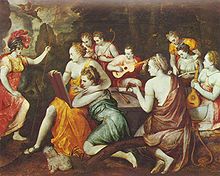Frans Floris

Frans Floris de Vriendt I (* 1516 [between April 17, 1515 and October 1, 1520] in Antwerp ; † October 1, 1570 there ) was a Flemish painter and, together with his brother, the sculptor and architect Cornelis Floris II , significantly involved in the development of the Nordic Renaissance .
Life
Floris was to become a sculptor, but then learned painting from Lambert Lombard in Liège and became a master in Antwerp in 1540. Then, like his brother Cornelis II, he went to Rome, where both of them continued their education, especially under the influence of Michelangelo and Vasari .
When he returned to Antwerp, he realized that the Italian conception of painting also required a new type of production. He built up a studio which, after Karel van Manders Schilder-Boeck, developed into a picture factory with over 100 helpers and journeymen and a sophisticated division of labor. So head studies were created that only had to be transferred by the assistants, which resulted in the sometimes recognizable stereotype of profiles. Frans Floris was soon called the "Dutch Raffael", but this too may have been part of his successful self-marketing, which also included the fact that his pictures by Hieronymus Cock , Cornelis Cort and Theodor Galle were soon engraved in copper and thus widely distributed. His brother Cornelis II. Frans Floris built a magnificent house that was decorated with pictures of the seven liberal arts , but has not been preserved. Alcohol sickness increasingly impaired his creativity. He died while working on a giant crucifixion and resurrection for a Spanish client.
plant

Not very much has been preserved of the extremely extensive production by Frans Floris. Some of his pictures fell victim to the iconoclasm , and on the other hand they were less appreciated in later times. The influence of Floris is very great and is by no means only to be seen on the aesthetic-stylistic level, but above all in the way of producing art based on the division of labor. The equally huge studio of a Peter Paul Rubens is inconceivable without Frans Floris forerunners. Floris loved the crowded body mass, was characterized by a very good knowledge of anatomy, but also tended to stereotype the same or similar athletic male backs and profiles. Influenced primarily by Franz Theodor Kugler , who described Floris' painting Lot and his daughters as "disgusting", Kugler's pupil Jacob Burckhardt also labeled the fall of the rebellious angels as "disgusting" - a judgment that explains more about the taste of the 19th century. Century says as about Frans Floris. As early as 1916 it was summarized: “Characteristic of Floris are slender figures and small heads, richly but swinglessly pleated antique garments and ingenious, bold brushwork. In mastering the Italian world of forms, he surpasses all of his predecessors. His loose, broad style of painting, his individual way of composing, and the style of his rare, individual, lavish portraits are of far-reaching importance for the following period. ”The presentation of musical events often found in Floris can also be found in his student Frans Francken the Elder , the father of the more famous Frans Francken the Younger again.
literature
- Hermann Arthur Lier : Vriendt, Frans de called Floris . In: Allgemeine Deutsche Biographie (ADB). Volume 40, Duncker & Humblot, Leipzig 1896, p. 373 f. (Deviating from 1517 or 1518 as year of birth)
- O. Granberg: Floris, Frans, eg. Frans de Vriendt [frint] . In: Theodor Westrin (Ed.): Nordisk familjebok konversationslexikon och realencyklopedi . 2nd Edition. tape 8 : Feiss-Fruktmögel . Nordisk familjeboks förlag, Stockholm 1908, Sp. 634-635 (Swedish, runeberg.org ).
- Max Rooses: III - The Italian Influence in the 16th Century . In: History of Art in Flanders . Julius. Hoffmann, Stuttgart 1914, p. 182–183 ( Textarchiv - Internet Archive - German translation by Johanna Gottschewski and E. Wiss, images of two works also on pp. 184–185).
- Dora Zuntz: Frans Floris. A contribution to the history of Dutch art in the XVI. Century. In: On the history of art abroad. Issue 130, JHE Heitz, Strasbourg 1929 (dissertation).
- Carl van de Velde: Frans Floris, Leven en Werken. 2 volumes, Paleis der Academien, Brussels 1975.
- Konrad Renger: Review of the work of van de Velde in the journal for art history . Volume 42, pp. 299-304.
Web links
- Frans Floris in van Manders Schilder-Boeck (original Dutch text)
- Frans Floris in the Web Gallery of Art
Individual evidence
- ↑ a b Friedrich Winkler : [Floris] Frans I. In: Ulrich Thieme (Hrsg.): General Lexicon of Fine Artists from Antiquity to the Present . Founded by Ulrich Thieme and Felix Becker . tape 12 : Fiori-Fyt . EA Seemann, Leipzig 1916, p. 123–126 ( Textarchiv - Internet Archive ).
- ↑ Ilse von zur Mühlen: Floris, Frans (1516) . In: Andreas Beyer, Bénédicte Savoy, Wolf Tegethoff (eds.): General Artists Dictionary - International Artists Database - Online . tape 41 : Fitzpatrick followers . De Gruyter, Saur, Munich / Leipzig 2004, p. 359 ( degruyter.com ).
- ↑ Harald Kümmerling: "Amor vincit omnia" by Frans Francken the Elder. Ä. In: Guitar & Lute. 2, 1980, 1, p. 48 (= picture or picture 5).
| personal data | |
|---|---|
| SURNAME | Floris, Frans |
| ALTERNATIVE NAMES | Floris de Vriendt, Frans |
| BRIEF DESCRIPTION | Dutch painter |
| DATE OF BIRTH | between April 17, 1515 and October 1, 1520 |
| PLACE OF BIRTH | Antwerp |
| DATE OF DEATH | October 1, 1570 |
| Place of death | Antwerp |

